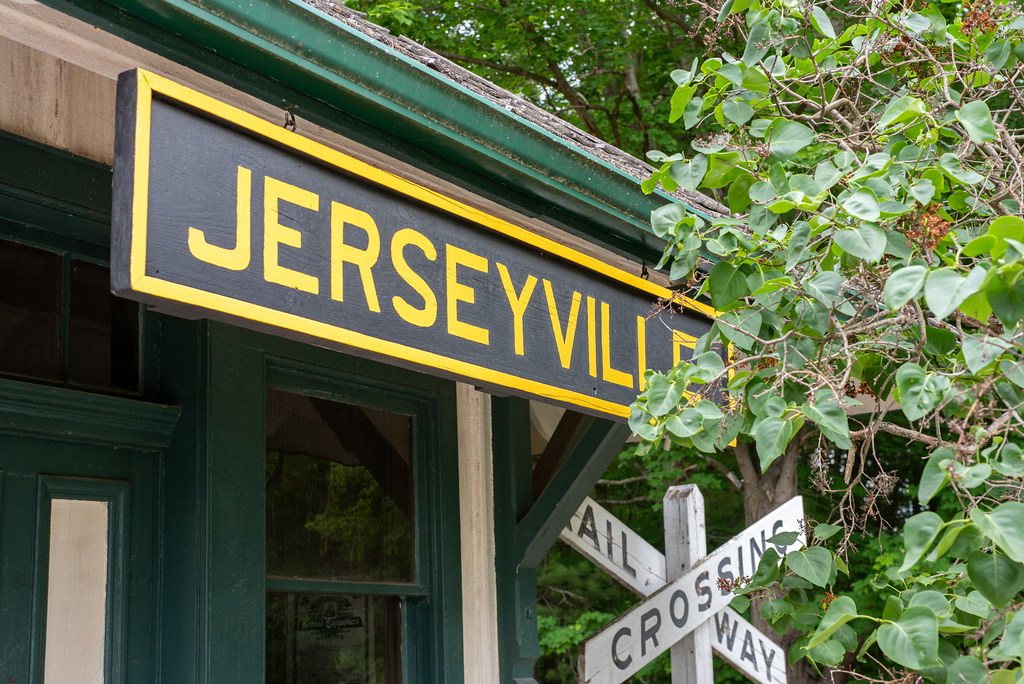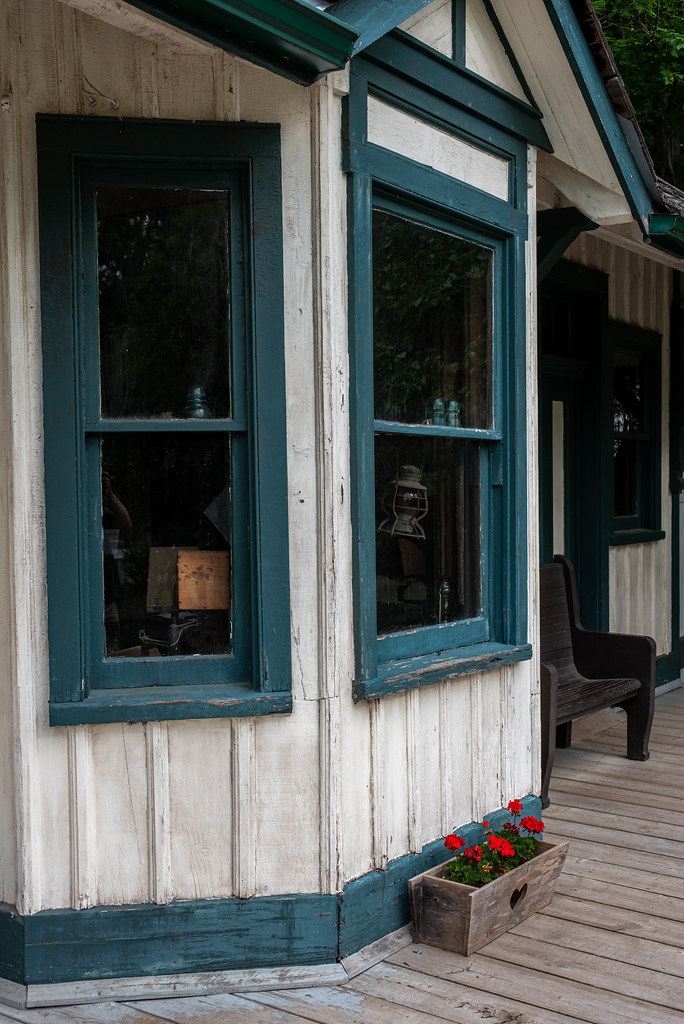If you’re a fan of the show Murdoch Mysteries and are a sharp-eyed viewer, then the station featured today will be recognizable, having appeared in the episode The Annoying Red Planet, where the titular character visits the community of Jerseyville. Jerseyville is no work of fiction but is a rural community between Brantford and Hamilton and was only ever served by the Toronto, Hamilton & Buffalo Railway.

Graflex Crown Graphic – Nikon Nikkor-W 1:5.6/180 – Ilford HP5+ @ ASA-200 – Pyrocat-HD (1+1+100) 9:00 @ 20C
The Toronto, Hamilton & Buffalo Railway saw its original charter in 1884 to construct a second line between the three cities mentioned in the name as an alternative to Grand Trunk, which by 1884 had full control over Buffalo & Lake Huron and Great Western Railway. But the charter put some serious restrictions on the construction of the line. Under the terms of the charter, they would be unable to enter into a traffic sharing agreement with any other railway operator or purchase an incomplete line to integrate into their network. These two reasons were enough to keep the charter on paper only, and it eventually lapsed. In 1892 new investors revised the charter and removed the restrictive sections of the charter to allow the line to be completed. One of the first things the new railway operator did to kick start the construction was absorb the incomplete Brantford, Waterloo & Lake Erie Railway. By 1892 this line had been completed between Waterford and Brantford. Rather than continue that line out to Waterloo, the route was realigned to take the railway to Hamilton, passing through Jerseyville and south towards Fort Erie and the International Railway Bridge. From Hamilton, the line would continue onto Toronto. Hamilton would be reached in 1894 and a year later would hit Welland. Stations would start construction in 1895, communities like Brantford and Hamilton received large ornate stations, especially the one in Hamilton. But for rural communities, simpler stations were completed. And for even more remote stops, little more than a shelter shed saw construction. But by this point, Toronto, Hamilton & Buffalo’s line saw no further construction. A joint effort between New York Central and Canadian Pacific Railway purchased the entire network jointly. Not an even split but enough that instead of a dedicated Toronto, Hamilton & Buffalo Line, points to Toronto and Buffalo were completed on either CP or CASO tracks.

Nikon D750 – AF-S Nikkor 28-70mm 1:2.8D
Nikon D750 – AF-S Nikkor 28-70mm 1:2.8D
The Jerseyville Station is an excellent example of a rural station for Toronto, Hamilton & Buffalo. Constructed to the Queen Anne Revival style but far more subdued with little ornamentation or architectural features. Wooden construction using board and batten. The station looks similar to the earliest stations constructed on Ontario railways for Ontario, Simcoe & Huron. Inside, the station features a small general passenger waiting room with large baggage and freight room. A station master’s office with a ticket window and telegraph bay separated the two larger areas. The telegrapher bay jutted out onto the platform to keep track of trains coming and going. The station opened to traffic in 1895, sitting on the north side of Jerseyville road, west of the centre of the village. Like many rural villages, Jerseyville remained isolated until the railroad arrived. Trains would allow residents to go into the city, and goods could come in and out by freight trains. And the station remained untouched during the first part of the 20th Century and never saw a replacement. Steam locomotives served the station initially, but Toronto, Hamilton & Buffalo were the first to start running diesel-electric locomotives. In the final years of service, diesel-powered trains visited Jerseyville. By 1954, with improved highways and readily available personal automobiles, passenger service through Jerseyville had ceased.

Nikon D750 – AF-S Nikkor 28-70mm 1:2.8D
Nikon D750 – AF-S Nikkor 28-70mm 1:2.8D
The station stayed in place and maintained some railway operations regarding freight services. Still, by the 1960s, Toronto, Hamilton & Buffalo were looking to divest themselves of underused stations, Jerseyville among them. A local farmer expressed interest in purchasing the old station for use on his farm. But another group, the Westfield Pioneer Association, purchased historically significant buildings to build a living history museum. Thankfully the Westfield group won the bidding war and moved the station near Rockton as one of the original buildings that formed the Westfield Pioneer village, which opened to the public in 1963. While I’m unsure if Toronto, Hamilton & Buffalo ever painted their stations a railroad red, the Jerseyville Station underwent some restoration work to its original appearance at Westfield. The station began home to a large collection of Toronto, Hamilton & Buffalo memorabilia. Westfield also acquired a maintenance shed and shelter type station both from Toronto, Hamilton & Buffalo. Westfield was the first to take a serious interest in preserving the history of Toronto, Hamilton & Buffalo. That station came under threat in the 1980s when financial difficulties forced Westfield to close; thankfully, the interest in film and television production gave the village a second life. In 1985 the station appeared in the CBC Anne of Green Gables TV movie and was also included in Road to Avonlea. Today, the station is one of only a few preserved examples of Toronto, Hamilton & Buffalo stations, Hamilton’s GO Centre and Smithville. The Brantford Station is still standing but is long abandoned, having been a restaurant in various forms. Toronto, Hamilton & Buffalo would come under full Canadian Pacific Control in 1985, and the reporting mark dropped in 1987. The original line from Brantford to Hamilton was torn up in the 1990s, and today is a walking trail and still crosses through Jerseyville. At Westfield, Jerseyville remains a fine example of the early passenger stations for the rail operator and a popular spot for TV and film production. In fact, the day I was photographing the station, I got in before a crew arrived to film a scene.
1 Comment